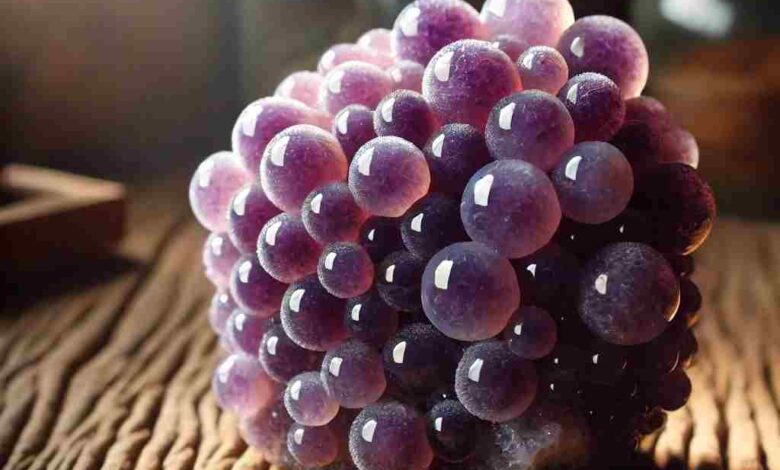What is Grape Agate? Properties, Occurrence, and More

Grape Agate, a name that resonates with both gemstone enthusiasts and mineral collectors, is a fascinating and relatively new discovery in the world of minerals. Its captivating grape-like appearance, vibrant colors, and intriguing properties make it a gemstone of considerable interest. In this article, we’ll delve into everything you need to know about Grape Agate, from its formation and physical properties to its occurrence and metaphysical significance.
What is Grape Agate?
Agate grape is more a botryoidal chalcedony and not exactly an agate. Botryoidal is the microcrystalline variety of quartz forming a botryoidal aggregate of chalcedony. It got the name “botryoidal” because it looks as if nature was imitating the shape of the bunches of grapes, with the Greek word “botrys” meaning “grape.” These small spheres usually measure between two and eight millimeters in diameter and are mostly purple, but they can also be found in shades of green, white, gray, and blue.
The term “Grape Agate” is one that has just stuck in the market because of its visual appeal and ease with which it describes the stone, though technically, “Botryoidal Chalcedony” or “Botryoidal Amethyst” would be more correct. The first large finds of Grape Agate were made in the Mamuju area of West Sulawesi, Indonesia, around 2016. This makes it quite a recent find in the gemstone world.
Physical Properties of Grape Agate
Grape Agate properties Grape agates are appreciated mainly for their aesthetic beauty, but they also have certain physical features. A relatively hard mineral, rating a 6.5 to 7 on the Mohs scale, it is used in all types of jewelry-making themes throughout history. This stone’s waxy luster and drusy surfaces make it sparkle and add to its appeal.
One of the most spectacular attributes to Grape Agate are its colors, mostly shades that vary from purples. This color is a result of the iron in quartz, even though it only has small parts. Once in a while, you discover Grape Agate green, the vividly colored version of this already rare and precious stone. Several specimens are even bicolored in green and purple, an attractive feature often sought after by those who collect rocks.
Occurrence and Formation
Most Grape Agate comes from an area near Mamuju in the Sulawesi Province of Indonesia. The stone forms inside cavities of volcanic rock, specifically andesitic to basaltic rocks. These cavities are formed when gas bubbles get caught in cooling lava from volcanic activity. These bubbles create the ideal environment for slowly crystallizing Grape over millions of years.
The stone began to form when silica-rich fluids migrated into the rock and cooled, settling in pockets. These leave behind tiny quartz crystals, which cluster together to create the characteristic botryoidal formations of Grape Agate as this liquid solidifies. This process takes millions of years, resulting in the beautiful natural sculptures that are mined today.
Metaphysical Properties and Uses
Grape Agate is not only an aesthetically pleasing stone but also a crystal with high metaphysical properties. It is linked to the crown and third eye chakras in numerology, as well as in the crystal healing and metaphysical world. Grape is thought to boost paranormal senses, clear intuition, and help you understand your dreams. Many crystal lovers place Grape Agate near their bedside to help with more vivid, clearer dreams and assist in spiritual growth.
Grape Agate has a very calming energy and aids in stress relief, as well as in alleviating various kinds of anxieties. It is known to create inner peace and balance, making it an exceptional gemstone for meditation or other spiritual practices. It is also believed to help with communication, group participation, or public speaking, as it encourages you to tell the truth and speak from your heart without holding anything back.
In both a physical and spiritual sense, Grape Agate is also used in healing practices, supporting the immune system, gastrointestinal health, and general body processes. Despite a lack of scientific proof, many in the metaphysical community praise this stone’s healing properties.
How to Care for Grape Agate
Taking care of Grape is pretty straightforward, but there are a few things that you must keep in mind. It’s certainly about the hardest-wearing stone, but like all natural stones, one should take care not to keep it in water for a long time, as over a period of multiple days, its top surface will begin to etch or lose luster. Ideally, you should avoid using moisture-based cleansing such as water or saltwater soaking to cleanse the stone and opt for dry methods like smudging with sage or placement in a bowl of salts.
Store Grape Agate away from harder gemstones to prevent scratches. One fine way to do so is by wrapping it with a soft cloth or storing it in another section of your jewelry box.
Grape Agate in Jewelry and Decoration
With its one-of-a-kind look, Grape Agate is now being used more commonly in jewelry and ornamental pieces. Its bold purple color and grape-shaped clusters make it ideal for pendants, earrings, and rings. Fragile specimens, especially small clusters, are best for gently used pieces. Grape is another kind of stone often used for jewelry and home decor as well.
You can present large masses of the stone as freeform sculptures and bring in that wild appeal to any space. These examples are highly searched by collectors and lovers for their unique looks.
FAQs
1. What is Grape Agate, and why is it called that?
Grape Agate is a botryoidal form of chalcedony, which is a type of microcrystalline quartz. The name “Grape Agate” comes from its appearance, as it forms in clusters that resemble bunches of grapes. While it is called “agate,” it is technically more accurate to refer to it as “botryoidal chalcedony” or “botryoidal amethyst” due to its composition and structure.
2. Where is Grape Agate found?
Grape is primarily found in the Mamuju area of Sulawesi, Indonesia. This is the only known significant locality for this mineral, making it relatively rare. The stone forms in volcanic rock cavities, specifically in andesitic to basaltic rocks, which were formed by volcanic activity millions of years ago.
3. What are the metaphysical properties of Grape Agate?
Grape Agate is believed to have strong metaphysical properties, particularly in enhancing psychic abilities, intuition, and dream recall. It is associated with the crown and third eye chakras and is said to promote spiritual growth, mental clarity, and emotional balance. It is also used to reduce stress, anxiety, and improve communication.
4. How can I care for my Grape Agate?
To care for Grape, avoid prolonged exposure to water, as it can damage the stone’s surface. Instead, clean it using dry methods like smudging or placing it in a bowl of salt. Store it separately from harder gemstones to avoid scratches, ideally in a soft cloth or a separate compartment in a jewelry box.
5. Can Grape Agate be used in jewelry, and is it durable?
Yes, Grape is often used in jewelry due to its unique and attractive appearance. It is relatively durable with a Mohs hardness of 6.5 to 7, making it suitable for everyday wear in pendants, earrings, and rings. Due to its delicate structure, especially in small clusters, it’s best for items not exposed to rough use.
The Bottom Line
This and its unique characteristics are what makes Grape so mesmerizing. If you collect for beauty, metaphysical qualities, or rare stones, then Grape is a must-have. Grape, formed in Indonesian volcanic rocks, inspires and amazes people worldwide in spiritual practices. Grape is something special, whether you are an experienced gemstone collector or just starting out. Its beauty, rarity, and meaning will keep it popular for years.




